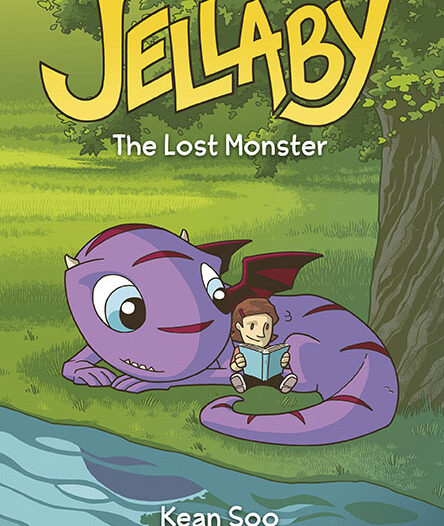
Review: Jellaby: The Lost Monster
 Jellaby: The Lost Monster
Jellaby: The Lost Monster
By Kean Soo
Capstone; $12.95
Cartoonist Kean Soo’s big, purple, vaguely quotation mark-shaped monster returns in a new edition of the 2008 graphic novel, ready and waiting for new grade-schoolers to discover him—along with any older readers who might have missed the book the first time around.
Soo’s Jellaby began life as a web comic and made frequent appearances in short strips Soo contributed to about a half-dozen of the lauded Flight anthologies, eventually starring in a pair of graphic novels for kids. The Lost Monster was the first; originally just titled Jellaby, it has now picked up a sub-title. Other changes to, and features of, this edition include a new full-color cover and back cover, a foreword by Flight editor Kazu Kibuishi, two pages of sketches, and a two-page Q-and-A with Soo.
ADVERTISEMENT
ADVERTISEMENT
Jelllaby is a big, bipedal, dragon-esque monster that seems to be about sixty-percent head. He has tiny little horns and tiny little wings, and red stripes that run from the tip of his tail to the middle of his face, that final one doubling as a nose in Soo’s design, accentuating the puppy dog looks of the extremely expressive, but always silent, Jellaby. The creature does the majority of his communication through vigorous nods or shakes of the head and with his dinner plate eyes.
A little girl named Portia finds Jellaby shuffling around in the woods outside her bedroom window one night, looking sad, hungry and maybe a little scared. Portia, who has some rather serious problems of her own—including trying to fit in at her new school, the rather mysterious absence of her father, and bad dreams that are only slightly scarier than a bad memory concerning the night her father disappeared—invites Jellaby in for a sandwich and then more or less adopts him.
When Jellaby notices a little classmate of hers being bullied at recess, he guilts her into intervening, and the two then share the secret of Jellaby…as well as a joint sense of responsibility for his welfare and, of course, a blossoming friendship. Ultimately this means the two little kids decide they have to help Jellaby get home, and the only clue they have to go on as to his origins is that the mute monster recognizes something in the newspaper about Toronto.
The kids, like Jellaby, are all head in design—one thus suspects Jellaby of being a kid himself—looking like extremely tiny adults who have yet to grow into their enormous, somewhat abstracted-in-comparison-to-those-of-the-adults heads. The interior artwork is all black, white, purple and red…more purple than anything else, with the red sparingly used on Jellaby’s wings and stripes and an article of Portia’s clothing, linking the two as kindred spirits. The only other colors used are orange and green, on Jason’s t-shirt, which has a carrot on it (Jason really likes carrots).
The book ends on a rather inconclusive cliffhanger—the better to get you to read the next volume, one supposes—but the story between these newly-designed, newly-drawn covers is a charming one full of pantomimed humor and personality friction, with mysterious, even sad sub-plots boiling underneath.
Filed under: Reviews
About J. Caleb Mozzocco
J. Caleb Mozzocco is a way-too-busy freelance writer who has written about comics for online and print venues for a rather long time now. He currently contributes to Comic Book Resources' Robot 6 blog and ComicsAlliance, and maintains his own daily-ish blog at EveryDayIsLikeWednesday.blogspot.com. He lives in northeast Ohio, where he works as a circulation clerk at a public library by day.
ADVERTISEMENT
ADVERTISEMENT
SLJ Blog Network
Happy Poem in Your Pocket Day!
This Q&A is Going Exactly As Planned: A Talk with Tao Nyeu About Her Latest Book
Parsing Religion in Public Schools
Environmental Mystery for Middle Grade Readers, a guest post by Rae Chalmers
ADVERTISEMENT







